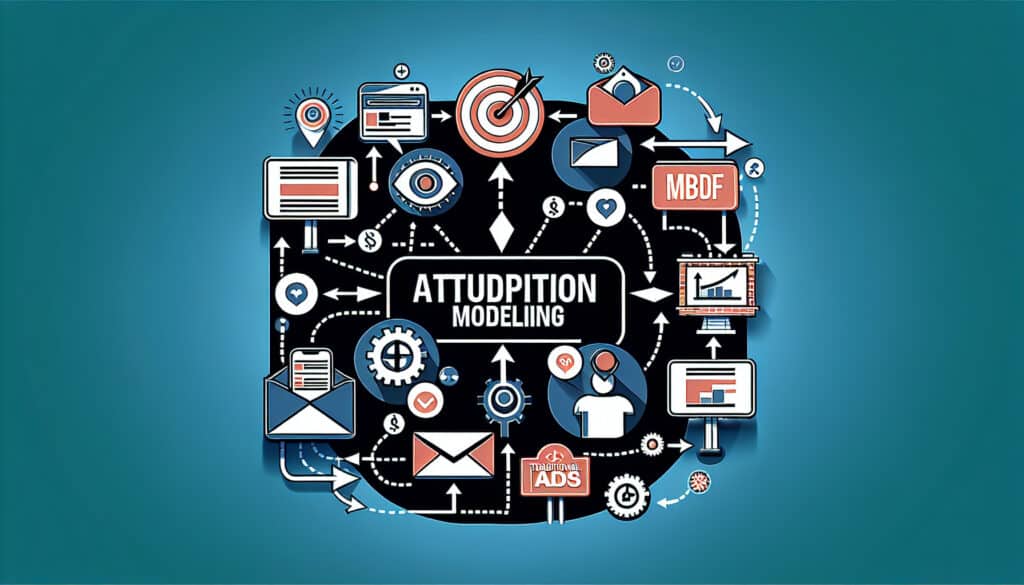Le processus d'attribution des crédits aux différents commercialisation points de contact avec lesquels un client interagit au cours de son parcours vers la conversion.
- Méthodologies : Lean Sigma, Fabrication
Modélisation de l'attribution

Modélisation de l'attribution
- Tests A/B, Taux de conversion, Expérience client, Cartographie de l'itinéraire du client, Marketing numérique, Stratégie marketing, Suivi des performances
Objectif :
Comment il est utilisé :
- Les modèles d'attribution sont utilisés pour comprendre quels canaux de marketing sont les plus efficaces pour générer des conversions. Ces informations peuvent ensuite être utilisées pour optimiser les dépenses de marketing.
Avantages
- Il fournit des informations sur l'efficacité des différents canaux de marketing, aide à optimiser les dépenses de marketing et peut être utilisé pour améliorer le parcours du client.
Inconvénients
- Elle peut être complexe à mettre en œuvre, nécessite des données précises sur les points de contact marketing et il n'existe pas de modèle d'attribution unique qui convienne à toutes les entreprises.
Catégories :
- Clients et marketing, Économie
Idéal pour :
- Comprendre l'impact des différents canaux de marketing sur les conversions.
La modélisation d'attribution est largement utilisée dans divers secteurs, notamment le commerce électronique, la vente au détail et le marketing numérique, où les entreprises cherchent à recueillir des données sur les interactions des consommateurs avec différents canaux de marketing avant de procéder à un achat. Par exemple, dans le cadre d'une campagne de publicité numérique, les entreprises utilisent souvent des modèles d'attribution multicanaux pour évaluer les performances de canaux tels que les médias sociaux, le marketing par courriel et les annonces de recherche payantes. Ce processus se déroule généralement pendant la phase d'évaluation d'une stratégie marketing, où les analystes de données, les responsables marketing et les concepteurs de produits se réunissent pour analyser le comportement des utilisateurs sur différentes plateformes. La collaboration au sein de l'équipe est cruciale, car la combinaison de l'expertise technique et des connaissances en marketing permet d'interpréter les données avec plus de précision. Les professionnels spécialisés dans l'analyse des données peuvent utiliser des techniques statistiques pour créer des modèles qui quantifient la contribution de chaque point de contact à la conversion finale. En adoptant les techniques de modélisation de l'attribution, les entreprises peuvent ajuster leurs stratégies de marketing et leur allocation budgétaire de manière efficace, en veillant à ce que les ressources soient dirigées vers les canaux qui présentent le meilleur retour sur investissement. La compréhension de la corrélation entre les différents efforts de marketing et les ventes permet non seulement d'éclairer les décisions budgétaires, mais aussi de concevoir des expériences pour les clients, ce qui permet aux entreprises d'améliorer efficacement leurs stratégies de sensibilisation et d'engagement. De telles méthodologies peuvent s'adapter aux besoins des industries confrontées à l'évolution des comportements des consommateurs, aidant ainsi les marques à rester compétitives tout en affinant leurs approches marketing.
Principales étapes de cette méthodologie
- Sélectionner les canaux à analyser en fonction de la stratégie de marketing.
- Déterminer les objectifs de conversion et les indicateurs clés de performance.
- Choisir un modèle d'attribution (par exemple, dernier clic, premier clic, linéaire, décroissance temporelle).
- Attribuer les crédits de conversion aux points de contact marketing selon le modèle sélectionné.
- Analyser les résultats pour identifier les tendances et les écarts de performance.
- Ajuster les tactiques de marketing en fonction des données d'attribution afin d'optimiser les dépenses.
- Affiner en permanence le modèle d'attribution au fur et à mesure que de nouveaux canaux et de nouvelles données sont disponibles.
Conseils de pro
- Utilisez l'attribution multi-touch pour obtenir une vue complète des interactions avec les clients sur différents canaux afin d'analyser les performances avec plus de précision.
- Intégrer des algorithmes d'apprentissage automatique pour affiner les modèles d'attribution de manière dynamique, ce qui permet des ajustements en temps réel en fonction de l'évolution du comportement des consommateurs.
- Validez et mettez régulièrement à jour vos modèles d'attribution par rapport aux données de conversion réelles afin de garantir un alignement permanent sur l'évolution des conditions et des stratégies du marché.
Lire et comparer plusieurs méthodologies, nous recommandons le
> Référentiel méthodologique étendu <
ainsi que plus de 400 autres méthodologies.
Vos commentaires sur cette méthodologie ou des informations supplémentaires sont les bienvenus sur le site web de la Commission européenne. section des commentaires ci-dessous ↓ , ainsi que toute idée ou lien en rapport avec l'ingénierie.
Contexte historique
1960
1980
1983
1990
1995
2000
2010
1950
1980
1980
1986
1994
1995
2000
(si la date est inconnue ou n'est pas pertinente, par exemple "mécanique des fluides", une estimation arrondie de son émergence notable est fournie)














Articles Similaires
Gestion des opérations de fabrication (MOM)
Système d'exécution de la fabrication (MES)
Plan de contrôle de la fabrication
Tests manuels
Tableaux d'évaluation des manutentions manuelles (MAC)
ManTRA (outil d'évaluation des risques liés aux tâches manuelles)